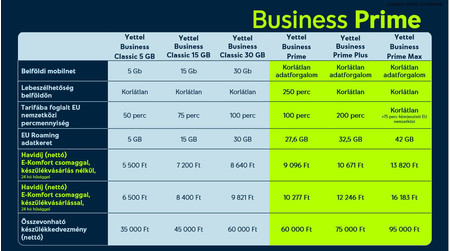Based on the latest mobile market report published by the National Media and Infocommunications Authority (NMHH)[1], Yettel is the market leader in Hungary based on the market share of active SIM cards used for M2M communication. This position is further strengthened by the availability of LTE-M technology on Yettel’s mobile network. This technology offers enhanced capabilities developed specifically to support machine-to-machine (M2M/IoT) communication. As part of another major improvement in the field of M2M/IoT, Yettel has significantly increased the nationwide coverage of its already existing NarrowBand Internet of Things (NB IoT) network. This special technology is now available in 70% of Hungary’s territory. Yettel has also improved its response time to fulfil scattered NB IoT needs in still uncovered areas.
Tariff portfolio to SMB needs
Consumer Prime tariffs were announced by the operator upon launching the Yettel brand. The key benefits of those tariff plans include unlimited service, faster customer service and group-based discounts. From now on, business customers, particularly SMBs can also enjoy the benefits of unlimited service. The new business portfolio aligned to Prime tariffs is named Business Prime. The new business tariffs include more services responding to the needs of their target groups such as free SMS messages and international airtime. In addition to high-end Business Prime tariffs, Yettel’s new business portfolio also includes tariff plans with lower data allowances and 100% free airtime.
The new world of M2M communication – talking to machines
Machine to machine (M2M) networks typically have a large number of beacons involved in communication with low data traffic and mobile internet bandwidth requirements (such as the beacons of water companies integrated into water meters). Due to the large number of beacons, their unit price is an important factor. The price of beacons can be kept low if they are assembled using not the most advanced components but components providing the necessary minimum capabilities for M2M communication and they don’t have unused features that would unnecessarily increase their price.
Some of these beacons are fixed – such as a consumption meter sending signals to the central system once a month. The beacons of the M2M system operate on a special NB IoT network that supports M2M needs using very low (~70 kbps) bandwidth. Previously, Yettel’s NB IoT coverage was confined to Transdanubia and Budapest. As a result of continuous development, the service is now available in 70% of Hungary’s territory. With network modernization going on, this coverage keeps increasing, but the operator is able to expand its NB IoT network on an on-demand basis also to still uncovered areas.
There are many companies developing solutions for M2M communication in the field of public utility services, healthcare, security technology, transport security, etc. The available network capabilities support data transfer rates higher than that of NB IoT to enable even the transmission of visual content and full mobility in M2M communication with less complex and cheaper devices. These capabilities require more advanced (and more costly) beacons. Nevertheless, manufacturers still want to fulfil advanced needs with components offering the necessary minimum features. This is how the standard and device class named CAT-M emerged – together with the LTE-M capability supporting this standard on the network side.
The biggest innovation of LTE-M over NB IoT is that it enables two-way communication. That is, a beacon doesn’t only send signals and then returns to sleep mode, but the central system can also address the individual machines, terminals, more advanced equipment, cameras, etc. through the LTE-M network. LTE-M supports text messages and voice calls in M2M communication that was not available over the NB IoT network before. These features significantly expand the use cases of the new technology. Yettel already offers LTE-M connectivity to its customers in about 60% of the territory of Hungary thanks to ongoing development.
Both NB IoT and LTE-M provide network capabilities relevant for the long term. The use of these capabilities will dynamically rise in the future. They are most likely to be used for business applications, but the adoption of LTE-M-capable smart accessories (e.g., smart watches) may also increase their use in the consumer segment.
[1] NMHH Mobile Market Report – H1 2021: https://nmhh.hu/dokumentum/225891/NMHH_mobilpiaci_jelentes_2017Q3_2021Q2.pdf


